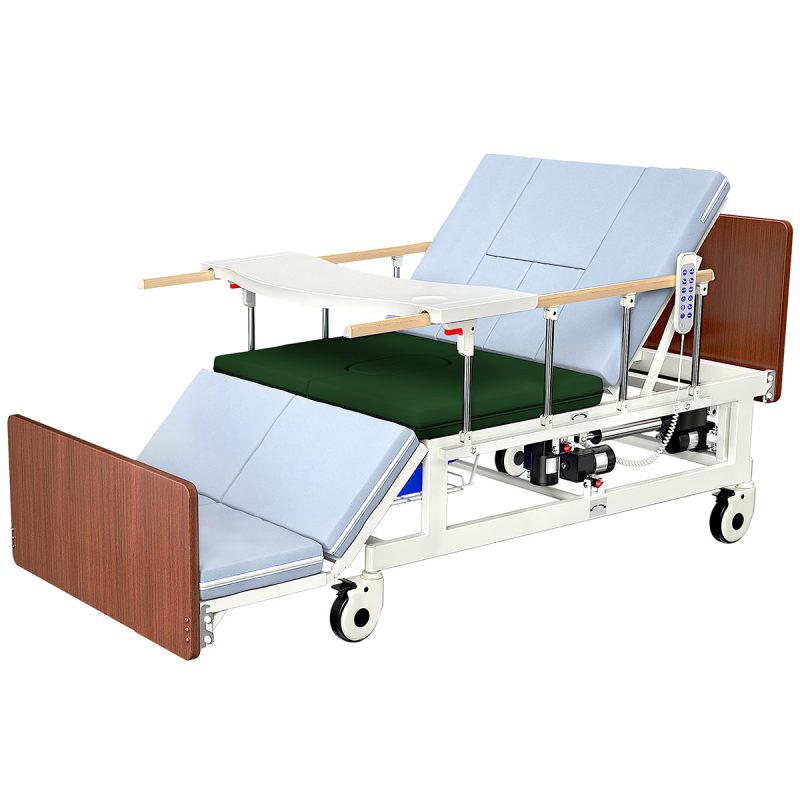The best hospital beds for home use depends on the specific needs of the patient, but generally, a fully electric hospital bed is considered the most versatile and user-friendly option. These beds allow for easy adjustments to the head, foot, and height sections with the touch of a button, making them ideal for patients who need frequent repositioning to prevent bedsores or enhance circulation. They also reduce the physical strain on caregivers, who can adjust the bed without manual effort. For larger patients, bariatric beds offer greater weight capacity and durability, while low hospital beds are suitable for those with a high risk of falling. When choosing a hospital bed, consider the type of mattress, as options like foam, air, and alternating pressure mattresses provide varying levels of support and pressure relief. Essential safety features such as side rails, locking wheels, and smooth edges are also important to prevent injuries. Additional accessories like overbed tables and trapeze bars can further enhance the functionality and comfort of the bed. Ultimately, the best hospital bed for home use is one that aligns with the patient’s medical requirements, provides maximum comfort, and ensures ease of use for both the patient and the caregiver.
Types of Hospital Beds
- Manual Hospital Beds: These beds require manual adjustments using hand cranks. They are cost-effective but may not be suitable for patients who need frequent position changes or lack the strength to operate the cranks.
- Semi-Electric Hospital Beds: These beds have electric motors for adjusting the head and foot sections, while the height is adjusted manually. They offer a balance between convenience and cost.
- Fully Electric Hospital Beds: These beds provide complete electric adjustment for height, head, and foot sections. They are the most convenient and easy to use, ideal for patients who need frequent repositioning.
- Bariatric Hospital Beds: Designed for larger patients, these beds have a higher weight capacity and wider dimensions. They often come with reinforced frames and additional support features.
- Low Hospital Beds: These beds can be lowered closer to the floor to reduce the risk of injury from falls. They are suitable for patients with mobility issues or a high risk of falling.
Key Features to Consider
- Adjustability: Ensure the bed allows for easy adjustment of the head, foot, and height sections. Fully electric beds are the most convenient for this purpose.
- Size and Weight Capacity: Choose a bed that comfortably accommodates the patient’s size and weight. Bariatric beds are ideal for larger patients.
- Mattress Type: Select a mattress that offers adequate support and pressure relief. Options include foam, air, and alternating pressure mattresses.
- Safety Features: Look for beds with side rails, locking mechanisms, and smooth edges to prevent injuries.
- Ease of Use: Ensure the bed is easy to operate, especially if caregivers will be making frequent adjustments.
Three Key Questions
1.What Are the Benefits of a Fully Electric Hospital Bed?
A fully electric hospital bed provides the highest level of convenience and ease of use. With electric adjustments for the head, foot, and height sections, caregivers can easily reposition the patient without physical strain. This is particularly beneficial for patients who need frequent changes in position to prevent bedsores or improve circulation. The electric controls make it simple for the patient to adjust the bed independently, promoting a sense of autonomy and comfort.
2.How Do I Choose the Right Mattress for a Hospital Bed?
Choosing the right mattress for a hospital bed is crucial for the patient’s comfort and health. Foam mattresses are a popular choice for their support and affordability. For patients at high risk of pressure ulcers, alternating pressure mattresses are ideal as they help to distribute weight and reduce pressure points. Air mattresses offer customizable firmness levels and are suitable for long-term use. Consider the patient’s specific needs, such as susceptibility to bedsores or chronic pain, when selecting a mattress.
3.What Additional Features Should I Consider for a Home Hospital Bed?
Additional features can enhance the functionality and safety of a home hospital bed. Side rails provide added security and help prevent falls. An overbed table is useful for meals, reading, or other activities. Trapeze bars can assist patients with mobility and repositioning. Wheels with locking mechanisms ensure the bed can be moved easily and then secured in place. These features contribute to a safer and more comfortable environment for both the patient and the caregiver.
Choosing the best hospital bed for home use involves considering the patient’s medical needs, comfort, and safety. Fully electric beds offer the highest level of convenience, while the right mattress and additional features can significantly enhance the patient’s quality of life. By understanding the different types of hospital beds and their key features, you can make an informed decision that best suits your loved one’s needs.
If you are considering purchasing a hospital bed, please visit the official website of epachois,here:https://www.epachois.com/


